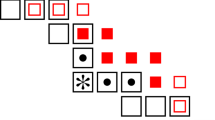Abstract
We study the activation process in undirected graphs known as bootstrap percolation: a vertex is active either if it belongs to a set of initially activated vertices or if at some point it had at least r active neighbors, for a threshold r that is identical for all vertices. A contagious set is a vertex set whose activation results with the entire graph being active. Let m(G, r) be the size of a smallest contagious set in a graph G. We examine density conditions that ensure that a given n-vertex graph \(G=(V,E)\) has a small contagious set. With respect to the minimum degree, we prove that if G has minimum degree \(n{\slash }2\) then \(m(G,2)=2\). We also provide tight upper bounds on the number of rounds until all nodes are active.
For \(n \ge k \ge r\), we denote by M(n, k, r) the maximum number of edges in an n-vertex graph G satisfying \(m(G,r)>k\). We determine the precise value of M(n, k, 2) and M(n, k, k) assuming that n is sufficiently large compared to k.
D. Freund—Supported in part by U.S. Army Research Office grant W911NF-14-1-0477.
M. Poloczek—Supported by the Alexander von Humboldt Foundation within the Feodor Lynen program, and in part by NSF grant CCF-1115256.
D. Reichman—Supported in part by NSF grants IIS-0911036 and CCF-1214844, AFOSR grant FA9550-08-1-0266, and ARO grant W911NF-14-1-0017.
Access this chapter
Tax calculation will be finalised at checkout
Purchases are for personal use only
Similar content being viewed by others
References
Ackerman, E., Ben-Zwi, O., Wolfovitz, G.: Combinatorial model and bounds for target set selection. Theor. Comput. Sci. 411, 4017–4022 (2010)
Amini, H., Cont, R. Minca, A.: Resilience to contagion in financial networks. Math. Finance (2013)
Amini, H., Fountoulakis, N.: What I tell you three times is true: bootstrap percolation in small worlds. In: Goldberg, P.W. (ed.) WINE 2012. LNCS, vol. 7695, pp. 462–474. Springer, Heidelberg (2012)
Balogh, J., Bollobás, B.: Bootstrap percolation on the hypercube. Prob. Theor. Relat. Fields 134, 624–648 (2006)
Balogh, J., Bollobás, B., Duminil-Copin, H., Morris, R.: The sharp threshold for bootstrap percolation in all dimensions. Trans. Am. Math. Soc. 364, 2667–2701 (2012)
Balogh, J., Pete, G.: Random disease on the square grid. Random Struct. Algorithms 13, 409–422 (1998)
Balogh, J., Pittel, B.: Bootstrap percolation on the random regular graph. Random Struct. Algorithms 30, 257–286 (2007)
Chalupa, J., Leath, P.L., Reich, G.R.: Bootstrap percolation on a Bethe lattice. J. Phys. C Solid State Phys. 12, L31 (1979)
Chen, N.: On the approximability of influence in social networks. SIAM J. Discrete Math. 23, 1400–1415 (2009)
Coja-Oghlan, A., Feige, U., Krivelevich, M., Reichman, D.: Contagious sets in expanders. In: Proceedings of the 26th Symposium on Discrete Algorithms (SODA 2015), pp. 1953–1987 (2015)
Janson, S., Łuczak, T., Turova, T., Vallier, T.: Bootstrap percolation on the random graph \(G_{n, p}\). Ann. Appl. Prob. 22, 1989–2047 (2012)
Kempe, D., Kleinberg, J.M., Tardos, É.: Maximizing the spread of influence through a social network. Theor. Comput. 11, 105–147 (2015)
Nichterlein, A., Niedermeier, R., Uhlmann, J., Weller, M.: On tractable cases of Target Set Selection. Soc. Netw. Anal. Min. 3, 233–256 (2013)
Ore, O.: Note on Hamilton circuits. Am. Math. Monthly 67, 55 (1960)
Przykucki, M.: Maximal percolation time in hypercubes under two-dimensional bootstrap percolation. Electron. J. Comb. 19, 1–13 (2012)
Reichman, D.: New bounds for contagious sets. Discrete Math. 312, 1812–1814 (2012)
Acknowledgments
The authors would like to thank the reviewers for their valuable comments that helped improving the presentation of the paper significantly.
Author information
Authors and Affiliations
Corresponding author
Editor information
Editors and Affiliations
Rights and permissions
Copyright information
© 2016 Springer International Publishing Switzerland
About this paper
Cite this paper
Freund, D., Poloczek, M., Reichman, D. (2016). Contagious Sets in Dense Graphs. In: Lipták, Z., Smyth, W. (eds) Combinatorial Algorithms. IWOCA 2015. Lecture Notes in Computer Science(), vol 9538. Springer, Cham. https://doi.org/10.1007/978-3-319-29516-9_16
Download citation
DOI: https://doi.org/10.1007/978-3-319-29516-9_16
Published:
Publisher Name: Springer, Cham
Print ISBN: 978-3-319-29515-2
Online ISBN: 978-3-319-29516-9
eBook Packages: Computer ScienceComputer Science (R0)




